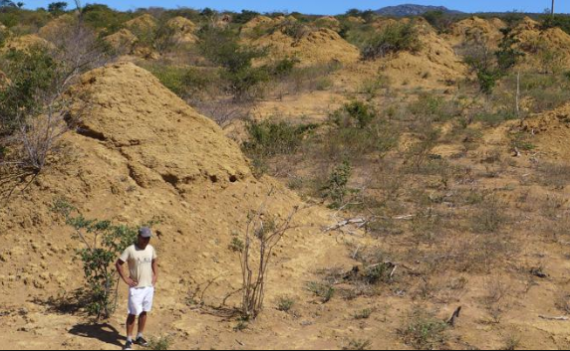
One of the largest and most complex terrestrial megalopolis is almost unknown, and has not been built by man: a group of scientists has just calculated, with the help of satellite images, the real extension of the expanse of mounds of earth raised by the termites in the Caatinga forest, in the north-east of Brazil. They found out that it is made up of about 200 million earth cones (murundus, in Portuguese) up to 2.5 meters high and up to 9 meters wide, which together cover an area of about 233.000 square km: more or less as the Great Britain.
WASTE MATERIALS. Roy Funch (Universidade Estadual de Feira de Santana, Brazil) knows these sophisticated architectural works from the 80s, but it is only in recent times that deforestation has made the blocks of land stacked by termites better recognizable.These social insects are known to erect complex tower-shaped buildings with intricate tunnel systems in which to swarm. The murundus, however, are something different: they are not inhabited nests, but heaps of discarded land while these animals work in chains of underground tunnels, buried between a cone and the other and below them. In hundreds, even thousands of years, the earth put aside is piled up in these cone-shaped structures without internal structures.
A MORE EXTENDED AREA. In 2015, Funch and colleagues estimated there were about 90 million cones, for a land volume equivalent to that of 900 Giza pyramids. The new and more precise images of Google Earth lead us to think of 200 million cones and a loose earth volume of 4000 Giza pyramids. More the work of a geological force than of a set of organisms.“To make a comparison, these cones occupy an area roughly equivalent to the Great Barrier Reef – an example of multispecies bioengineering structure,” says Funch. “However, the cones we are talking about are built from a single species of termite”, the Syntermes dirus, whose workers are about 2.5 cm long.
ALMOST 4000 YEARS. On the first Funch thought that each cone corresponded to a colony of insects, but analysing the specimens at the feet of each has realised that a single colony can be responsible for the formation of several cones: a tactic, to expand in the territory, to occupy vast tracts of forest and to access as many leaves as possible. The soil samples taken from the murundus have finally revealed the age: 690 years the youngest, 3,820 the oldest. We can therefore hypothesise intergenerational structures.
img source: google sorry didn't have other sources for it.
saifer link
